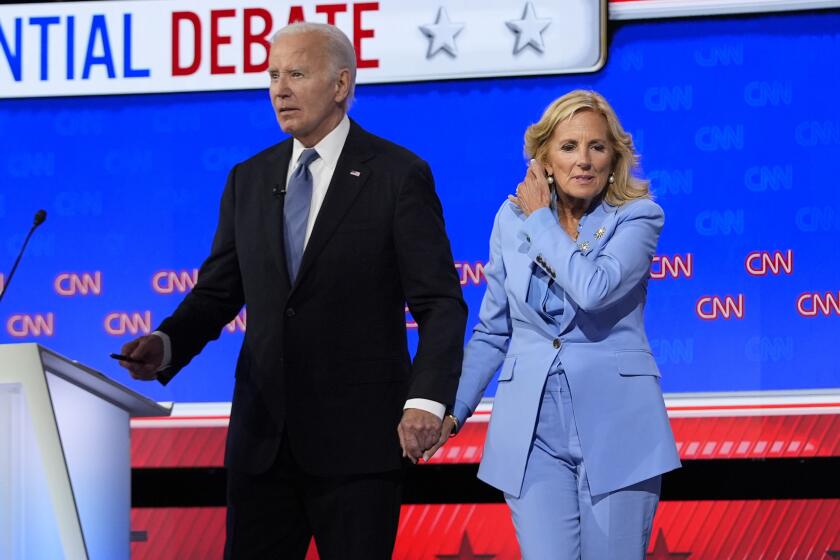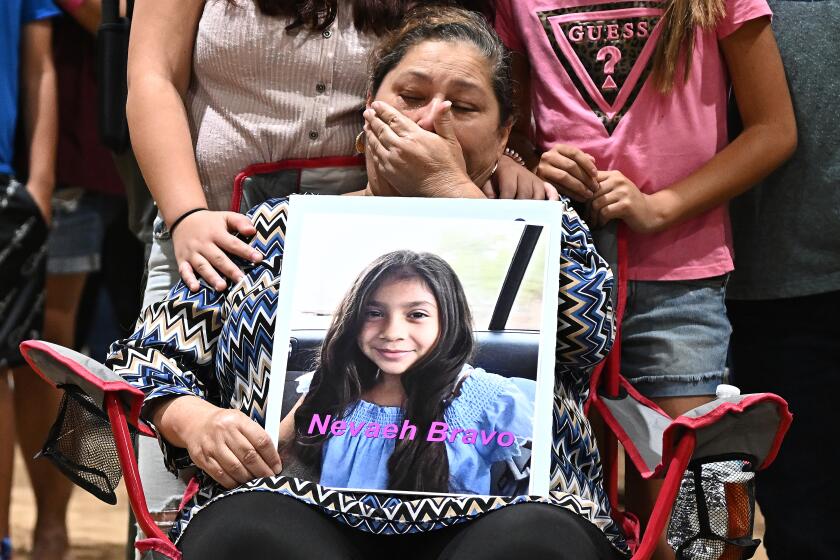Column: The surgeon general acknowledged America’s gun violence emergency. Here’s why that matters

- Share via
Hey, cheer up: The news is not all bad.
The federal government acknowledged for the first time last week that gun violence is an urgent public health crisis.
You already knew that, of course. We all knew it. But thanks to the gun lobby‘s stranglehold on our political class, it’s been nearly impossible to focus the federal government’s attention — and money — on this shameful and uniquely American problem.
That’s why the “Surgeon General’s Advisory on Firearm Violence” is so encouraging.
Abcarian: Yes, Biden looked and sounded awful. But the debate didn’t change the stark choice we face
The president’s appearance was far worse than the substance of what he said, while Donald Trump offered a forceful presentation of lies and nonsense.
In fed-speak, an advisory is the equivalent of sending up a flare; it is reserved for a situation that, as Surgeon General Vivek Murthy put it, requires “the nation’s immediate awareness and action.”
About damn time.
In the past few years, firearms have surpassed car accidents as the leading cause of death among children and adolescents. Almost 60% of gun deaths are suicides, and over the past decade, young adults have experienced what Murthy described as a “staggering increase” in gun suicide rates.
“We don’t have to continue down this path,” Murthy said in introducing the report, “and we don’t have to subject our children to the ongoing horror of firearm violence in America.”
Texas Gov. Greg Abbott and other pro-gun politicians should be forced to see the carnage caused by assault weapons in school shootings.
Gun violence has so warped us that nearly three-quarters of American adults report stress about the possibility of a mass shooting, and one-third say that fear of gun violence prevents them from going to certain places or attending certain events. More than half of Americans have had some sort of exposure to firearm violence, according to the Kaiser Family Foundation.
I don’t know about you, but I almost never walk into a theater or attend a large outdoor gathering without at least a fleeting thought about what I would do if gunfire broke out. I have almost completely stopped honking at people when I drive — even when they deserve it — because I don’t want to get shot by some hothead with a handgun.
By treating gun violence as a public health crisis and treating firearms as we do other potentially dangerous consumer products — such as cars, pesticides, cigarettes or prescription drugs — Murthy said we can reduce gun deaths, injuries and the almost incalculable indirect costs and community trauma that firearms cause.
This is a revolutionary stance for a reason. In 1996, a pro-gun congressman tucked a one-sentence amendment into the budget bill: “None of the funds made available for injury prevention and control at the Centers for Disease Control and Prevention may be used to advocate or promote gun control.”
For the next quarter-century, that amendment basically paralyzed the CDC’s ability to study gun violence. The equation was simple: no money = no research.
“The federal investment in firearm violence research is drastically less than the federal investment in research for causes of death with comparable mortality,” Murthy wrote, noting that research on drownings and car crashes are far better funded.
“We didn’t ignore firearm violence; we deliberately turned our back on it,” said Garen Wintemute, an emergency medicine physician and director of the Violence Prevention Research Program at UC Davis. “It’s as if we said, ‘Let’s not do research on breast cancer.’ How many thousands of people are dead today who would have been alive if we had done back in the ’70s, ’80s and ’90s the research on firearms that we are doing now? If we’d put interventions into place?”
Wintemute, a longtime member of the National Rifle Assn. who grew up around guns, is a pioneer in the field of gun violence prevention and has relentlessly advocated interventions that have been shown to work.
“We have good evidence that community-based and hospital-based violence interruption programs work,” he told me last week. “We have reasonable evidence that extreme risk protection orders work — like domestic violence restraining orders and red flag laws.”
Most Americans agree.
“There’s very little difference between gun owners and non-gun owners on whether they think these things are a good idea,” said Wintemute. “It’s so frustrating we can’t get public sentiment converted into public policy, at least at the federal level.”
Like me, he was surprised that our generally gun-happy Supreme Court recently ruled 8-1 in favor of a 1994 federal law that bans firearms for people under restraining orders for domestic violence. (Justice Clarence Thomas cast the only dissenting vote.)
The court surprised again last week, turning down a 2nd Amendment challenge to an Illinois law banning sales of semiautomatic rifles and pistols as well as large-capacity magazines. The law was passed after a gunman killed seven people and wounded 48 at a Fourth of July parade in a Chicago suburb.
Wintemute said the Biden administration has done a “superb” job of trying to rein in gun violence.
In 2022, the administration issued a rule regulating ghost guns, untraceable firearms assembled from separately acquired parts or kits and frequently used in crimes. The rule requires that such parts carry serial numbers and be sold only by licensed dealers and that their sale be subject to background checks.
In April, the Justice Department finalized rules to close the gaping “gun show loophole,” which has allowed firearms to be sold at gun shows and online without background checks.
“It’s not that Americans are more violent than other people,” Wintemute said. “It’s that we have unique access to a technology that changes the outcome of violence.”
More to Read
A cure for the common opinion
Get thought-provoking perspectives with our weekly newsletter.
You may occasionally receive promotional content from the Los Angeles Times.













